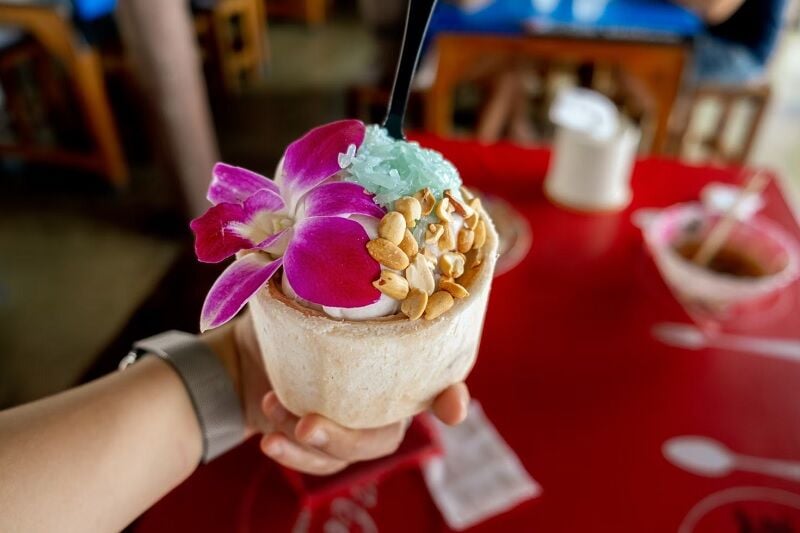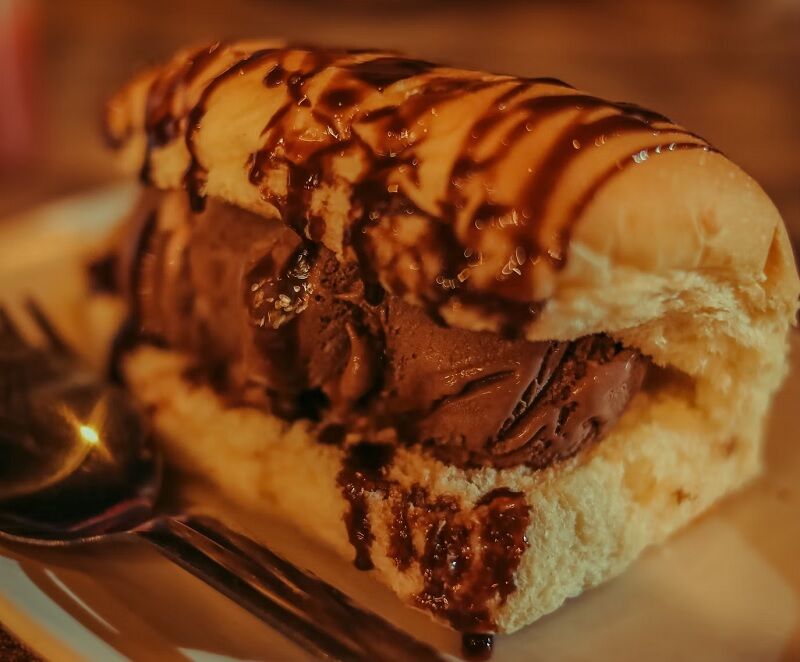Exploring the delicious history of famous Thai desserts

Diving into the rich tapestry of Thai cuisine, you’ll find a sweet thread woven through its history – the evolution of Thai desserts. These treats are not just a feast for the palate but a mirror reflecting centuries of culture, trade, and innovation. From the royal courts of Ayutthaya to the bustling streets of Bangkok, Thai desserts have been a cornerstone of Thai heritage, telling tales of influence and ingenuity.
At the heart of this sugary saga is Thao Thong Kip Ma, a historical figure whose contributions to Thai dessert culture are unparalleled. Known also as Maria Guyomar de Pinha, her life story intertwines with the political and social upheavals of 17th-century Siam, yet her legacy lives on through the royal desserts that grace Thai tables to this day.
They are a vibrant testament to Thailand’s history, its people, and the myriad influences that have shaped its culinary traditions. So, let’s embark on a journey through time, where each bite tells a story of its own.
Evolution of Thai desserts

As you explore the illustrious path Thai desserts have traveled, it’s clear this journey reflects Thailand’s deep-rooted history and rich tradition. The evolution of these sweet concoctions tells a story of cultural exchange, innovation, and the enduring legacy of Thai culinary artistry.
Traditional Thai ingredients
The bedrock of traditional Thai desserts is a trio of natural ingredients: coconut, rice, and sugar. These staple components have shaped the landscape of Thai sweets for centuries. Early dessert recipes harnessed the simplicity and availability of these ingredients, crafting delights that are both delicious and reflective of Thailand’s agricultural heritage. Rice flour or glutinous rice provides the base for many desserts, offering a chewy texture that’s become synonymous with Thai treats. Coconut milk adds creaminess and a subtle fragrance, while sugar introduces sweetness, balancing the flavors. This combination has not only sustained the traditional taste profiles but also paved the way for culinary creativity within the bounds of Thai dessert making.
Influence of different cultures
The history of Thailand is a tapestry of cultural exchanges, and its desserts are no exception. Portuguese influence in the 16th and 17th centuries introduced the use of eggs and the method of baking, infusing Thai desserts with new textures and flavors. Dishes such as Thong Yip (Pinched Gold), Foi Thong (Golden Threads), and Khanom Mo Kaeng (Thai Custard) bear witness to this blend of culinary traditions. Moreover, the encounters with Western and other Asian cuisines have led to inventive fusions, like the curry puff, which marries Western pastry techniques with the intricate spices of Indian cuisine.
The influence extends beyond ingredients and methods to the very soul of Thai dessert making. For example, Look Choup, colorful mung bean sweets shaped into miniature fruits, exemplifies the Thai penchant for aesthetics, inspired by the artistry of Portuguese sweets. These cultural infusions have not only diversified the flavors and techniques found in Thai desserts but have also enriched the country’s culinary narrative, making each bite a testament to Thailand’s dynamic history and its openness to the world.
In your venture through the history of famous Thai desserts, it’s evident that these sweet treats are more than just endings to a meal. They are storied chapters of Thailand’s rich cultural tapestry, continuous threads that weave through the past, present, and future of Thai culinary artistry, keeping the essence alive while adapting to the changing tastes and influences of the time.
Popular Thai desserts through the ages
Diving into the rich tapestry of Thailand’s culinary heritage, you’ll discover popular sweet delights that have graced tables for centuries. Among these, a few stand out not just for their flavours but also for their historical significance.
Khanom Chan
Khanom Chan, often described as a layered dessert, is a testament to the meticulous artistry of Thai dessert making. Its history stretches back through the ages, serving as a traditional offering in ceremonial occasions. It’s made from coconut milk, sugar, and flour, then colored and layered to create a visually striking treat. This dessert doesn’t just tantalise your taste buds; it’s a bite into the rich cultural fabric of Thailand, embodying the precision and patience of Thai culinary practices.
Mango Sticky Rice
Mango Sticky Rice, known locally as Khao Niew Mamuang, has an enigmatic origin that many believe dates back to the Ayutthaya period (1351-1767 AD). The resurgence in its popularity, however, is unquestionable. Characterised by sweet glutinous rice paired with the lush sweetness of ripe mangoes and a decadent drizzle of coconut milk, Mango Sticky Rice not only captures the essence of Thai flavours but also celebrates the country’s agricultural bounty. The best time to enjoy this famous Thai dessert is between April and June, mango season in Thailand, ensuring the freshest and most flavorful experience.
Tub Tim Grob
Tub Tim Grob, translating to Crispy Rubies, offers an exquisite culinary experience, marrying the crunchy texture of water chestnuts with the creamy richness of coconut milk. This dessert stands as a vibrant spectacle, with jewel-like water chestnuts coated in a tactile jelly, floating in sweet coconut milk. It encapsulates the innovation and flair of Thai dessert making, transforming simple ingredients into a dish that’s both a feast for the eyes and the palate. Its origins, while not precisely dated, are deeply rooted in Thailand’s inventive dessert history, showcasing the seamless blend of texture and taste that Thai cuisine is celebrated for.
These desserts are more than just sweet treats; they’re cultural landmarks. Each spoonful tells a story of historical significance, agricultural heritage, and culinary innovation, making them timeless favorites not just in Thailand but around the globe.
Innovative twists on classic Thai desserts

The history of Thailand’s culinary delights is steeped in tradition. Yet, as you explore the evolution of famous Thai desserts, it’s evident that innovation plays a crucial role. Chefs across the nation have been reimagining traditional recipes, adding a contemporary twist that both surprises and pleases the palate. Here’s a look at how classic treats have been transformed.
Ice Cream Roti
Imagine the warm, comforting embrace of Roti, a staple in Thai street food, now paired with the cool, creamy indulgence of ice cream. This innovative take blends the best of both worlds. Vendors skillfully cook the roti to achieve that perfect golden-brown crust before enveloping a generous scoop of ice cream inside. This delightful fusion has become a hit, especially in Bangkok’s bustling streets. It demonstrates how traditional dishes can adapt, offering a refreshing take that respects the past while embracing the future.
Durian Crepe Cake
Durian, the king of fruits, with its potent aroma and rich taste, has found its way into a French-inspired creation – the crepe cake. Stacking thin, delicate crepes with layers of durian-infused cream, this dessert is a testament to Thailand’s innovative spirit in the culinary world. It’s a bold combination, appealing to both durian lovers and those intrigued by its notorious reputation. This dessert showcases how Thai cuisine is unafraid to experiment, merging international techniques with local flavours.
Thai Tea Panna Cotta
The rich, aromatic Thai tea transforms into a silky, smooth panna cotta, offering a sophisticated dessert experience. By infusing the creamy mixture with the distinct flavours of Thai tea, chefs create a dessert that pays homage to Thailand’s famous beverage. It’s a soothing finale to any meal, with the vibrant amber hue and subtle sweet-spicy notes captivating both the eye and the palate. This dessert epitomises modern Thai cuisine’s ability to innovate, proving that even the most traditional ingredients can be reimagined into something extraordinary.
Each of these desserts illustrates the dynamic nature of Thai cuisine, where history and innovation meet. As you delve deeper into the famous Thai desserts, it’s clear that the spirit of Thailand shines brightest when tradition and creativity coalesce.
Considering the above-shared details, you can also check out unique Thai foods that you will not find anywhere else. When you step into this cultural wonderland, you’re not just visiting a new place; you’re also embarking on a tantalizing taste adventure. From street-side stalls to high-end restaurants, there’s a unique dish waiting to surprise your palate. Here’s a look at some delectable foods that are quintessentially Thai and can’t be found anywhere else in the world.
Latest Thailand News
Follow The Thaiger on Google News:

![The best bakeries in Bangkok [2025] | Thaiger](https://thethaiger.com/wp-content/uploads/2023/11/Featured-Image-Template-4-220x150.webp)
























